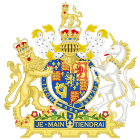Billingsgate Fish Market

Billingsgate Fish Market is located in Poplar in London. It is the United Kingdom's largest inland fish market. It takes its name from Billingsgate, a ward in the south-east corner of the City of London, where the riverside market was originally established. In its original location in the 19th century, Billingsgate was the largest fish market in the world.[1]
History
City of London
| Billingsgate, etc. Act 1698 | |
|---|---|
| Act of Parliament | |
 31 & 32 Vict. c. 45) | |
Status: Repealed | |
| Text of statute as originally enacted |



Billingsgate Wharf, close to
In 1850, the market, according to Horace Jones, "consisted only of shed buildings ... The open space on the north of the well-remembered Billingsgate Dock was dotted with low booths and sheds, with a range of wooden houses with a piazza in front on the west, which served the salesmen and fishmongers as shelter, and for the purposes of carrying on their trade." In that year the market was rebuilt to a design by J. B. Bunning, the City architect.[3]
Bunning's building was soon found to be insufficient for the increased trade, and in 1872 the
The opening of the railways changed the nature of the trade, and by the late nineteenth century most of the fish arrived at the market via the Great Eastern Railway.[3]
The infamously coarse language of London fishmongers made "Billingsgate" a byword for crude or vulgar language.[5] One of its earliest uses can be seen in a 1577 chronicle by Raphael Holinshed, where the writer makes reference to the foul tongues of Billingsgate oyster-wives. The market is depicted during Tudor times in Rosemary Sutcliff's 1951 children's historical novel The Armourer's House. The writer George Orwell worked at Billingsgate in the 1930s, as did the Kray twins in the 1950s.
Poplar
In 1982, the fish market was relocated to a new 13-acre (53,000 m2) building complex on the Isle of Dogs in Poplar, close to Canary Wharf and Blackwall. The freehold owner of the site is the London Borough of Tower Hamlets, but the City of London Corporation still runs the market; they pay an annual ground rent stipulated in an agreement between the two councils as "the gift of one fish".[6] Most of the fish sold through the market now arrives there by road, from ports as far afield as Aberdeen and Cornwall.
Billingsgate Market is open from Tuesday to Saturday. Trading commences at 4 a.m. and finishes at 8:30 a.m. Security for the market is provided by the private Market Constabulary.[7]
Traditionally, the only people allowed to move fish around the market were licensed fish porters. The role dates back at least to
Future
In early 2019, it was proposed in plans put forward by the Court of Common Council, the City of London Corporation’s main decision-making body, that Billingsgate Fish Market,
The new consolidated market is expected to become operational in 2027/2028,[11] at which point the Billingsgate Market site would be available for redevelopment. The future of the site is likely to include a mixed-use development to provide new homes and office spaces, as well as gyms, open space, hotel, restaurants and retail.
See also
References
- ^ Dunton, Larkin (1896). The World and Its People. Silver, Burdett. p. 24.
- ^ 'William III, 1698: An Act for making Billingsgate a Free Market for Sale of Fish. [Chapter XIII. Rot. Parl. 10 Gul. III. p.3. n.4.]', Statutes of the Realm: volume 7: 1695–1701 (1820), pp. 513–514. Accessed 9 March 2007
- ^ a b c Henry, Henry B. (1891), London Past and Present: Its History, Associations and Traditions, London: John Murray, p. 182
- ^ Parsons, R H (1947). History of the Institution of Mechanical Engineers. Institution of Mechanical Engineers. p. 183.
- ^ Word of the Day Archive - Monday June 12, 2006 accessed 21 May 2007
- ^ Shaffi, Sarah (28 July 2011). "Billingsgate Market rent paid in fish". East London Advertiser. Retrieved 8 June 2014.
- ^ "Billingsgate Market > About Billingsgate". City of London website. City of London. Archived from the original on 13 June 2011. Retrieved 2 March 2011.
- ^ "The Fish Market: Inside Billingsgate. BBC. Retrieved 30 May 2012
- ^ Tobin, Olivia (28 April 2019). "Historic Smithfield Market to move as preferred new location revealed". www.standard.co.uk.
- ^ "City of London gets planning permission for Dagenham markets move". ianVisits. 23 March 2021. Retrieved 27 November 2022.
- ^ "Our plans for the City's three historic food markets". Markets Co-location Programme. City of London Corporation. Retrieved 13 January 2023.
External links
- Official Billingsgate Market page from the City of London Corporation website
- Old official page


